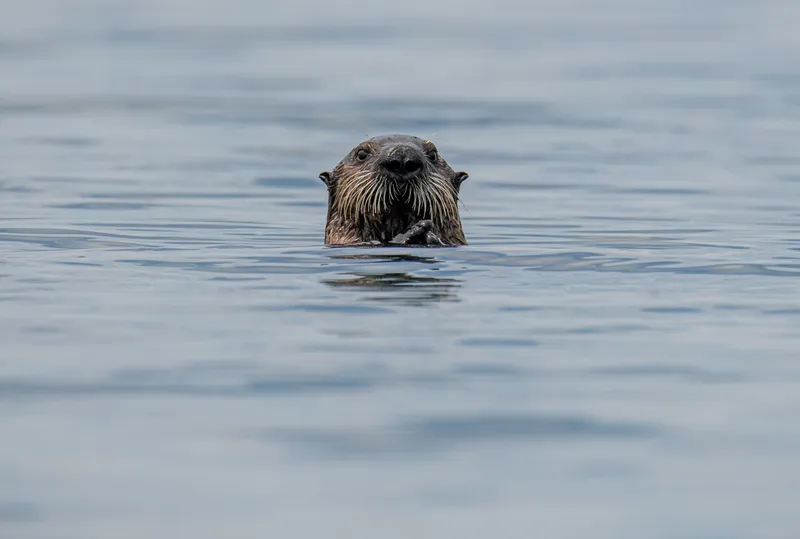[Sustainability Agenda] Otters, the river, and the unseen change – a Cauvery story
The river has faced varying issues including polluting sewage, dry patches, sand mining, and changes in rainfall patterns as a result of climate change.
Melting of the evening sun on the glimmering backwaters of Periyar with grazing gaurs and elephants is a sight that etches itself very easily in one’s memory. This experience becomes truly special when you add the small playful otters in the foreground of these giants in the forests. These otters are the smooth-coated ones, the most commonly occurring among the three otter species found in India.
The smooth-coated otters are found throughout India - from the Himalayas to the southern tip of the country, except in the Thar desert and parts of Kutch. Their social temperament and gregarious nature make them a delight to watch. However, over the last couple of decades, this widely distributed species is facing immense challenges due to sand mining in the rivers, changes to and loss of habitats which could be attributed to climate change and conversion, and humans competing for fish. The Cauvery delta is a good representative of what is happening to them across the country.

Otters being the top predator of river systems, are critical to the health of the river and therefore consequently, the delta.
The Cauvery River, the eighth largest river of the subcontinent, is the lifeline of the region It not just supplies water to Karnataka and Tamil Nadu but also has a profound influence on the culture and economy of the region, creating a delta along the 800 kilometres that it flows through while nourishing the lands from the wet evergreen forests to agriculture fields.
The river irrigates over 43 lakh acres of agricultural fields and provides water to 19 districts. Otters being the top predator of river systems, are critical to the health of the river and therefore consequently, the delta. The river has faced varying issues including polluting sewage, dry patches, sand mining, and changes in rainfall patterns as a result of climate change. And needless to say, all these factors combined have had a great impact on the otter population.
A study published by WTI in 2003 suggested that the otter population is on the decline due to anthropogenic pressures. One of the known threats they face is hunting by local communities as part of annual hunts. Additionally, fishing causes competition for food and sand mining takes away their homes, negatively impacting their breeding. What goes unnoticed, however, is the impact of climate change.
The rising temperatures and resultant changes in the climatic conditions and weather patterns have disturbed river systems, and Cauvery is no exception. The erratic rainfall, especially the heavy downpours in brief periods of time, causes flooding, which leads to the destruction of otter dens. Opposite to that is the lack of rain which dries up the river in many areas, causing loss of habitats and fishing grounds for these agile mammals.
While threats of poaching and sand mining might be the immediate causes of their population decline, climate change is driving severe, long-term and possibly irreversible impacts by directly impacting their living conditions. With all these factors combined, the otter populations might get completely wiped out locally if immediate and effective actions are not taken. Sadly, it is believed that the otter populations in many sections of the Cauvery, have already been wiped out, and soon, without any focused interventions, many other populations might be facing the same fate.
There is still hope, thanks to the resilient nature of the otters, who have recently been spotted after a long time in areas such as the Upper Anaicut near Mukkombu, Tamil Nadu. Are these remnant populations on the verge of local extinction or are these the signs of otters trying to adapt and revive? Whatever the case may be, an integrated development plan is required for the entire Cauvery basin that helps tackle not just local threats but mitigates the impact of climate change.
The river needs to be restored in places, illegal sand mining needs to be curbed, and poaching has to be `stopped’. Scientific approaches must be taken as mindless plantations along the river banks do not help, in fact, they destroy denning and nesting sites. Our hydrology needs to be studied and dams and flows need to be managed.
Thanks to the great will-power of the otters and their will to survive even in such dire conditions, we may still have the chance to not just revive their population, but also rejuvenate southern India’s lifeline: The Cauvery.
(Disclaimer: The views and opinions expressed in this article are those of the author and do not necessarily reflect the views of YourStory.)

![[Sustainability Agenda] Otters, the river, and the unseen change – a Cauvery story](https://images.yourstory.com/cs/5/f5a7f3304b1211e9b6645b8ae897d03e/Screenshot2022-06-30at3-1656581902713.png?mode=crop&crop=faces&ar=16%3A9&format=auto&w=1920&q=75)





